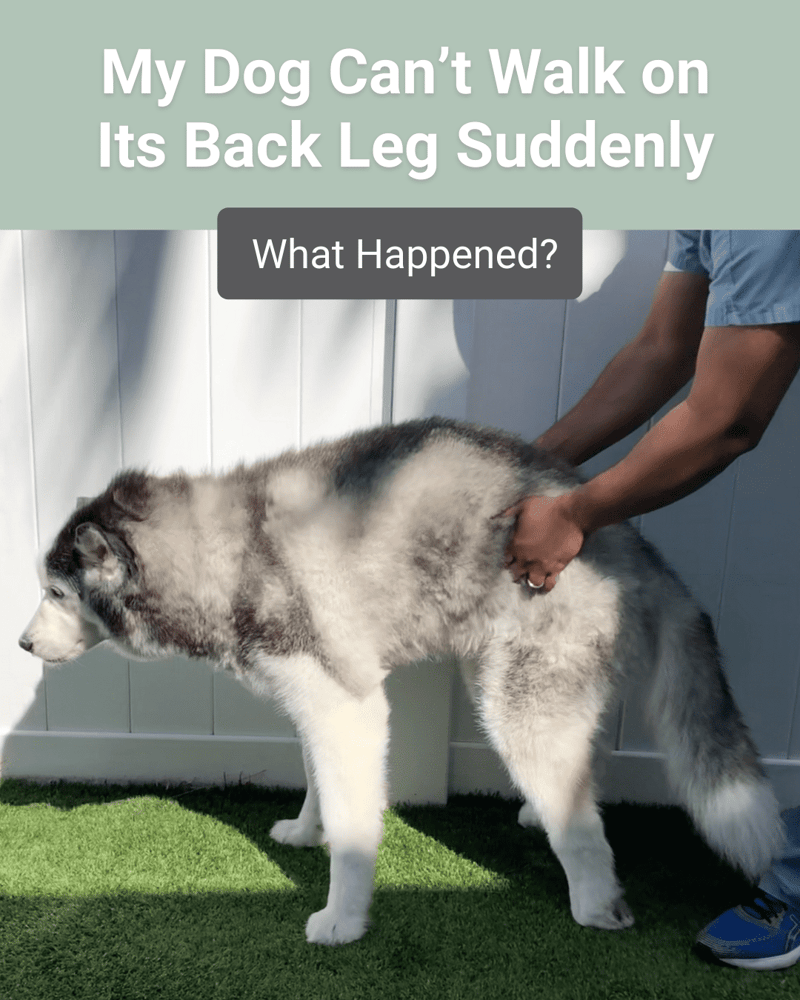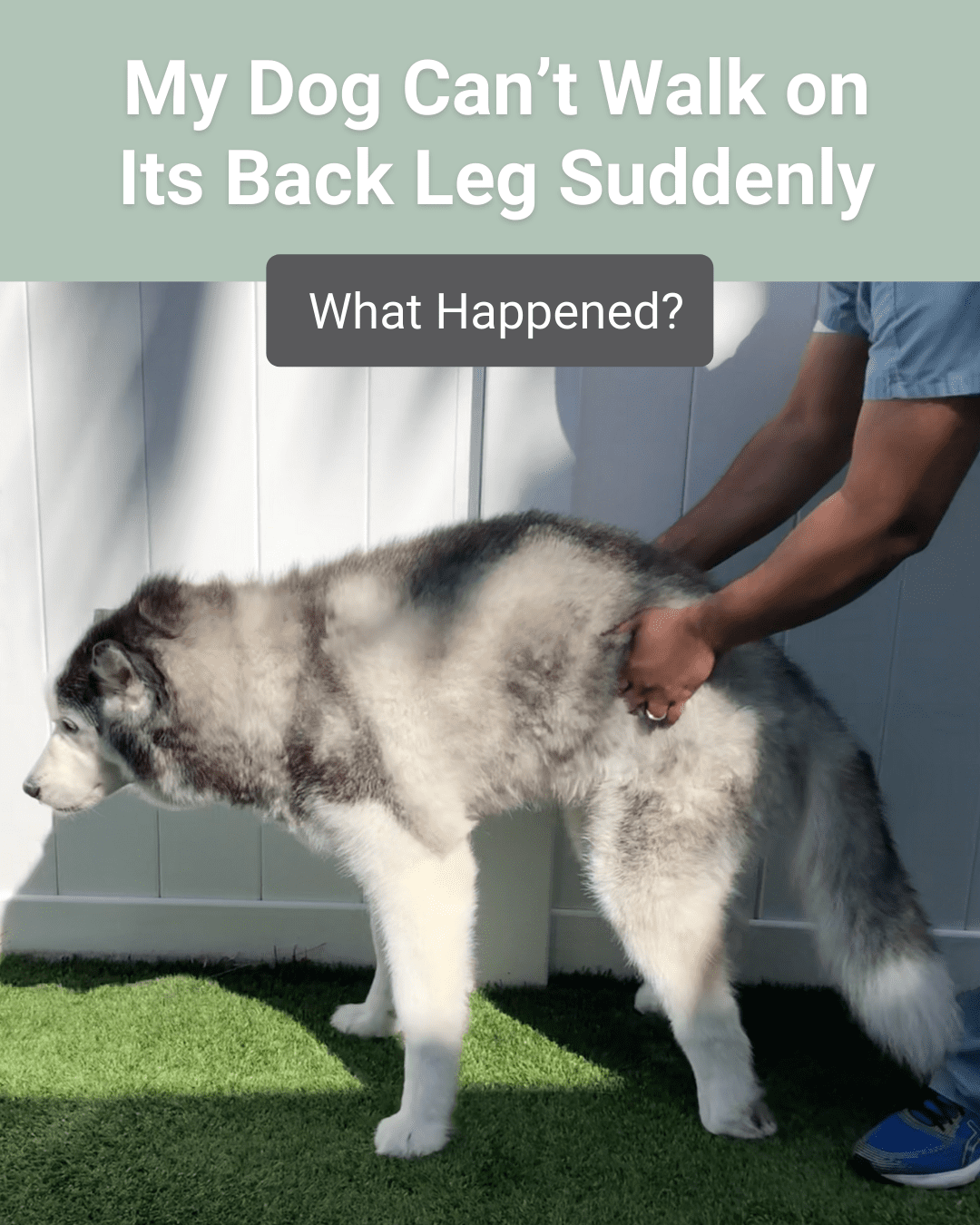Is your dog suddenly unable to walk? This change can be alarming and confusing. So let’s jump in deep: Why Can’t My Dog Walk All of a Sudden?
Dogs may stop walking for various reasons, ranging from minor injuries to serious health issues. As a pet owner, understanding the cause is crucial. It can help you make the best decisions for your furry friend. Sudden mobility loss can stem from pain, weakness, or even neurological problems.
Observing your dog’s behavior and condition is essential. This information can guide your next steps. Whether it’s a visit to the vet or a simple rest, knowing the reasons behind this sudden change can ease your worries. Let’s explore the possible reasons why your dog can’t walk all of a sudden and what you can do about it.
Table of Contents

Credit: aercmn.com
Sudden Canine Mobility Issues
Dogs can experience sudden mobility issues for various reasons. This can be alarming for pet owners. A dog that cannot walk may show signs of pain or discomfort. It’s important to understand these issues. Quick action can help your dog recover.
Recognizing The Signs
Watch for these signs in your dog:
- Difficulty standing: Your dog may struggle to get up.
- Shifting weight: Your dog may favor one leg.
- Unsteady gait: Your dog may wobble while walking.
- Vocalization: Your dog may whine or bark in pain.
- Avoiding movement: Your dog may refuse to walk.
Common Symptoms
Look for these common symptoms:
| Symptom | Description |
|---|---|
| Limping | Your dog may lift a leg while walking. |
| Swelling | Look for swollen joints or limbs. |
| Stiffness | Stiff movements, especially after rest. |
| Loss of appetite | Your dog may eat less or refuse food. |
| Excessive licking | Your dog may lick a painful area. |
Sudden mobility issues can result from injuries, illnesses, or age. Always consult a vet for advice. Quick diagnosis is key to recovery.

Credit: www.holistapet.com
Medical Emergencies Behind Sudden Paralysis
Sudden paralysis in dogs can be alarming. It may indicate serious health issues. Understanding the possible medical emergencies is crucial. These conditions often need immediate veterinary attention.
Spinal Injuries And Disorders
Spinal injuries can lead to sudden paralysis. These injuries may occur due to:
- Accidents
- Falls
- Trauma
Common spinal disorders include:
- Intervertebral Disc Disease (IVDD): Discs between the vertebrae can rupture.
- Spinal Stenosis: Narrowing of the spinal canal causes pressure on nerves.
- Vertebral Fractures: Broken vertebrae can affect mobility.
Symptoms of spinal issues may include:
- Weakness in the legs
- Loss of coordination
- Inability to walk
Neurological Conditions
Neurological conditions can also cause sudden paralysis. These may affect the brain or spinal cord. Common conditions include:
- Stroke: Blood flow to the brain is interrupted.
- Degenerative Myelopathy: A progressive disease affecting spinal cord function.
- Encephalitis: Inflammation of the brain due to infection.
Signs of neurological issues include:
- Disorientation
- Seizures
- Difficulty standing or walking
Act quickly if you notice these symptoms. Seek veterinary care immediately. Early diagnosis is key to treatment and recovery.
The Role Of Trauma And Accidents
Sudden inability to walk can be alarming for dog owners. Trauma and accidents often play a significant role in this issue. Understanding these factors can help you find solutions.
Physical Injuries
Injuries can happen anytime. Dogs are active and curious. Here are some common physical injuries:
- Fractures: Broken bones can cause severe pain.
- Sprains: Ligament damage can limit movement.
- Dislocations: Joints can slip out of place.
- Soft tissue injuries: Cuts or bruises can lead to limping.
Watch for signs like limping, whining, or avoiding weight on a leg. Seek immediate veterinary care if you notice these symptoms.
Post-traumatic Stress
Traumatic experiences can affect dogs emotionally. Just like humans, dogs can develop stress after an accident. This condition is known as Post-Traumatic Stress Disorder (PTSD).
Signs of PTSD in dogs may include:
- Excessive barking or whining
- Avoidance of certain areas
- Increased aggression or fear
- Changes in appetite or sleep
Helping a dog with PTSD requires patience. Provide a calm environment. Gradual exposure to triggers can help reduce fear.
Degenerative Diseases And Age-related Causes
When a dog suddenly cannot walk, it can be alarming. This issue often links to degenerative diseases or age-related conditions. Older dogs face more health problems. Owners need to understand these issues to help their pets.
Hip Dysplasia
Hip dysplasia is a common issue in older dogs. It happens when the hip joint does not fit into the hip socket properly. This condition can cause:
- Pain
- Inflammation
- Difficulty in walking
Signs of hip dysplasia include:
- Difficulty getting up
- Reluctance to walk or run
- Stiffness after resting
Regular check-ups can help catch this early. Treatment may include medication or surgery.
Arthritis And Osteoporosis
Arthritis and osteoporosis are other common causes for sudden mobility issues. Arthritis is the inflammation of joints. It leads to pain and stiffness. Osteoporosis weakens bones. This can make walking hard.
| Condition | Symptoms | Treatment |
|---|---|---|
| Arthritis | Pain, swelling, stiffness | Medication, weight management, exercise |
| Osteoporosis | Weak bones, fractures | Calcium supplements, medication |
Watch for changes in your dog’s behavior. If they show signs of pain, consult a vet.
Toxic Ingestion And Poisoning
Sudden inability to walk can be serious. One cause is toxic ingestion. Dogs may eat things that harm them. This can happen at home or outside. Recognizing the signs is crucial. Fast action can save your dog.
Household Toxins
Many common items in your home can poison dogs. Here are some common household toxins:
- Chocolate – Contains theobromine, harmful to dogs.
- Grapes and raisins – Can cause kidney failure.
- Onions and garlic – Damage red blood cells.
- Cleaning supplies – Many are toxic if ingested.
- Medications – Human meds can be deadly.
Always keep these items out of reach. Store them in secure places. Signs of poisoning may include:
- Vomiting
- Weakness
- Difficulty walking
- Excessive drooling
Outdoor Hazards
Your dog may face dangers outside. Toxic plants and chemicals are everywhere. Here are some outdoor hazards:
| Hazard | Effect on Dogs |
|---|---|
| Antifreeze | Can cause kidney failure. |
| Poisonous plants | May lead to vomiting or worse. |
| Pesticides | Can cause nervous system problems. |
| Rodenticides | Can be fatal if ingested. |
Be vigilant when your dog is outside. Familiarize yourself with toxic plants. Monitor their behavior closely. Quick action can help prevent serious harm.
Infectious Diseases That Affect Mobility
Sudden changes in your dog’s ability to walk can be alarming. Many factors can cause this. One major factor is infectious diseases. These diseases can severely impact your dog’s mobility. Understanding these conditions helps you act quickly.
Canine Distemper
Canine distemper is a serious viral infection. It affects dogs of all ages. The virus attacks the nervous system, respiratory system, and immune system.
Symptoms include:
- Fever
- Coughing
- Vomiting
- Diarrhea
- Nervous system issues
As the disease progresses, dogs may show signs of:
- Weakness
- Seizures
- Loss of coordination
Early diagnosis is crucial. Vaccination can prevent this disease. Talk to your vet about your dog’s vaccination status.
Tick-borne Illnesses
Tick-borne illnesses are another concern. They can cause severe health issues. Common tick-borne diseases include:
- Lyme disease
- Anaplasmosis
- Ehrlichiosis
These diseases can lead to:
- Joint pain
- Fever
- Fatigue
Dogs may become weak and unable to walk. Regular tick prevention is essential. Check your dog for ticks after walks.
| Disease | Symptoms | Treatment |
|---|---|---|
| Canine Distemper | Fever, coughing, nervous system issues | Supportive care, vaccination |
| Lyme Disease | Joint pain, fever, fatigue | Antibiotics, supportive care |
Watch for changes in your dog’s behavior. Prompt action can save your dog’s life.
Nutritional Deficiencies And Diet
A sudden inability to walk can stem from many causes. One key reason is poor nutrition. A dog’s diet plays a crucial role in its overall health. Nutritional deficiencies can lead to weakness and mobility issues.
Dogs need specific nutrients to stay strong and active. Lack of these nutrients can affect their muscles, joints, and bones. Understanding the importance of a balanced diet can help improve your dog’s health.
Importance Of A Balanced Diet
A balanced diet includes proteins, fats, carbohydrates, vitamins, and minerals. Each nutrient serves a unique purpose:
- Proteins: Build and repair tissues.
- Fats: Provide energy and support cell function.
- Carbohydrates: Offer quick energy.
- Vitamins and Minerals: Support various body functions.
Feeding your dog a diet rich in these nutrients helps maintain strength. Look for high-quality dog food that meets these nutritional standards.
Supplements And Joint Health
Sometimes, regular food alone may not suffice. Supplements can help fill nutritional gaps. This is especially true for joint health. Common supplements include:
| Supplement | Benefits |
|---|---|
| Glucosamine | Supports cartilage health. |
| Chondroitin | Helps reduce joint pain. |
| Omega-3 Fatty Acids | Reduces inflammation. |
Always consult a vet before starting any supplements. They can recommend the right options based on your dog’s needs. Proper nutrition and supplements can lead to better mobility.
Diagnosis And Veterinary Interventions
Finding out why your dog can’t walk suddenly is crucial. A proper diagnosis helps identify the problem. A veterinarian can perform various tests and suggest treatments. Understanding these steps can ease your worry.
Diagnostic Tests
Veterinarians use several tests to find the cause. Here are common diagnostic methods:
- Physical Examination: A thorough check of your dog’s body.
- X-rays: Helps view bones and joints.
- Blood Tests: Checks for infections or diseases.
- MRIs or CT Scans: Gives detailed images of the brain and spine.
- Neurological Tests: Assesses nerve function and reflexes.
Each test provides important information. The veterinarian will choose tests based on your dog’s symptoms.
Treatment Options
After diagnosis, treatment can begin. Options vary based on the underlying issue. Here are some common treatments:
| Treatment | Description |
|---|---|
| Medications | Pain relief and anti-inflammatory drugs. |
| Physical Therapy | Exercises to improve strength and mobility. |
| Surgery | Corrective procedures for serious conditions. |
| Rest and Recovery | Limiting activity to allow healing. |
| Supportive Care | Using braces or wheelchairs for mobility. |
Follow your vet’s recommendations. Early intervention can lead to better outcomes.
Home Care And Management
When a dog suddenly can’t walk, home care is vital. Proper management can help your dog feel better. You can support their recovery with a few simple changes.
Adapting Your Home
Make your home safe and comfortable for your dog. Here are some tips:
- Remove obstacles. Clear pathways of toys and furniture.
- Provide non-slip surfaces. Use mats or rugs to prevent slipping.
- Set up a cozy resting area. Use soft bedding in a quiet spot.
- Limit stairs. If possible, keep your dog on one level.
Consider using ramps or pet stairs. This helps your dog access furniture or the car easily.
Physical Therapy And Rehabilitation
Physical therapy aids recovery. It can help your dog regain strength and mobility. Here are some common methods:
- Gentle stretching. This keeps muscles flexible.
- Hydrotherapy. Swimming can be low-impact and fun.
- Massage. It can relieve tension and improve blood flow.
Consult your vet for a rehabilitation plan. Follow their guidance for the best results.
Prevention And Early Detection
Keeping your dog healthy is key. Sudden changes in walking can signal problems. Early detection can help avoid serious issues. Regular care is crucial for your pet’s well-being.
Regular Check-ups
Regular visits to the vet are important. These check-ups help catch problems early. Here are some reasons why:
- Vaccinations: Protect against diseases that affect mobility.
- Dental Care: Oral health impacts overall health.
- Weight Management: Obesity can limit movement.
- Joint Health: Early detection of arthritis or injuries.
Schedule check-ups at least once a year. Older dogs may need more frequent visits.
Recognizing Early Warning Signs
Pay attention to your dog’s behavior. Early signs can help prevent issues. Look for these warning signs:
- Difficulty standing: Struggling to get up can indicate pain.
- Change in gait: Limping or dragging paws needs attention.
- Excessive panting: Signs of distress or discomfort.
- Reluctance to play: Loss of interest in activities is concerning.
Keep track of any changes. Write them down to discuss with your vet.
| Warning Sign | Possible Issue |
|---|---|
| Difficulty standing | Pain, arthritis, or injury |
| Change in gait | Nerve issues or joint problems |
| Excessive panting | Heat, anxiety, or pain |
| Reluctance to play | Depression or physical discomfort |
Stay observant. Your dog’s health depends on it.
Stories Of Recovery And Hope
Many dog owners face sudden changes in their pets’ mobility. It can be alarming. Yet, countless stories show that recovery is possible. These stories inspire hope and resilience.
Success Cases
Many dogs have overcome sudden inability to walk. Here are some inspiring examples:
| Dog Name | Condition | Treatment | Outcome |
|---|---|---|---|
| Buddy | Hip Dysplasia | Physical Therapy | Can walk again |
| Luna | Intervertebral Disc Disease | Surgery | Full recovery |
| Max | Injury | Rest and Meds | Back to normal |
These stories show that many dogs can regain their mobility. With the right care, your dog can also recover.
Supportive Community Networks
Finding support is crucial for dog owners. Many online groups offer help and encouragement. Here are some benefits of joining these communities:
- Share experiences with others.
- Get advice from pet health experts.
- Find local resources for treatments.
- Access emotional support during tough times.
Communities provide a safe space. Owners can ask questions and share fears. They also celebrate successes together. Each story of recovery brings hope.
Connecting with others can be powerful. It builds a network of support. This network helps owners stay strong for their pets.

Credit: sevneurology.com
When To Say Goodbye
Deciding to say goodbye to a beloved pet is hard. Dogs bring joy and love. When they suddenly can’t walk, it raises many questions. Owners often wonder about their dog’s quality of life. Here, we discuss important factors to consider.
Quality Of Life Considerations
Assess your dog’s overall happiness and comfort. A few signs can help you evaluate:
- Eating habits: Is your dog eating well?
- Interaction: Does your dog engage with family members?
- Pain levels: Is your dog showing signs of pain?
- Mobility: Can your dog move around with ease?
Consider these factors:
| Sign | Explanation |
|---|---|
| Happiness | Does your dog still enjoy daily activities? |
| Pain | Is your dog in constant discomfort or distress? |
| Independence | Can your dog still perform basic needs? |
Euthanasia Decisions
Choosing euthanasia is a tough decision. It’s often made for the dog’s sake. Think about the following:
- Consult a vet: Get professional advice on your dog’s condition.
- Consider your dog’s pain: Is your dog suffering?
- Quality of life: Is your dog happy and comfortable?
- Family input: Discuss this decision with family members.
Trust your instincts. Listen to your heart. Sometimes, saying goodbye is the kindest choice.
Frequently Asked Questions
Why Can’t My Dog Walk Suddenly?
Sudden inability to walk can stem from various issues. Common reasons include injury, arthritis, or neurological problems. It’s crucial to observe any additional symptoms like limping or whining. If your dog cannot walk, consult a veterinarian immediately for a thorough examination and appropriate treatment.
Is My Dog’s Sudden Limping Serious?
Sudden limping can indicate serious underlying issues. It might be due to injuries, infections, or joint problems. Monitor your dog for other symptoms like swelling or pain. If limping persists or worsens, seek veterinary advice to ensure your dog’s health and well-being.
What Should I Do If My Dog Can’t Walk?
If your dog cannot walk, first assess for injuries. Check for visible signs of pain or discomfort. Keep your pet calm and comfortable. Avoid forcing them to walk. Contact a veterinarian for guidance, as timely intervention can prevent further complications.
Can Anxiety Cause My Dog To Stop Walking?
Yes, anxiety can lead to mobility issues in dogs. Stressful situations may cause them to freeze or refuse to walk. Changes in their environment or routine can trigger this behavior. If you suspect anxiety, consult a veterinarian or a dog behaviorist for effective solutions.
Conclusion
Sudden changes in your dog’s ability to walk can be alarming. Many factors might cause this issue. Pain, injury, or illness could be reasons. Always watch for other signs too. Seek help from a vet quickly. Early action can make a big difference.
Your dog’s health matters. Pay attention to their needs. Understanding the cause can help you provide better care. Stay alert to changes in behavior. With the right support, your dog can regain their strength and mobility.



